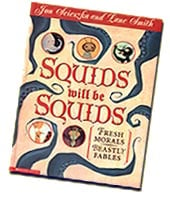 Tonight I was continuing my quest to find
Tonight I was continuing my quest to find new & different ways to teach fables, and look at what I've stumbled upon! (amazingggg!)
I can't wait to read it to the kiddos!
Squids Will Be Squids is full of brand-new, modern fables... and they couldn't be more different from Aesop's!
Jon Scieszka and Lane Smith's collection of fables poke fun at the old traditional fables
(just as their book The Stinky Cheese Man poked fun at traditional fairy tales).
Unlike Aesop's traditional animal characters, this crazy cast includes a sad squid, a duckbilled platypus, a piece of toast, a horseshoe crab, and even a beefsnakstik!
And the morals of these stories aren't bits of wisdom; instead, they are nonsensical modern messages, including: "Just because you have a lot of stuff, don't think you're so special," "Don't play with matches," and "Breakfast is the most important meal of the day."
book summary from scholastic.com
and a little activity..
In the beginning of Squids Will Be Squids, read aloud the short, funny introduction to Aesop and his fables.
To teach your class what the elements of a fable are, begin by reading a few aloud. Some classic fables that many of your students will probably recognize are "Wolf in Sheep's Clothing," "The Ant and the Grasshopper," "The Tortoise and the Hare," and "The Fox and the Grapes." After you have finished these stories, ask your class what all of these fables had in common. They will probably discover for themselves the two
prominent characteristics of a fable, which are:
All fables feature animals (or occasionally, objects) who speak and act like human beings,
Why are fables are told with animals rather than with people (hmmmm)?.
and they all have a moral.(a lesson drawn from a story that teaches correct behavior or a universal truth).
Would a fable still be a fable if it didn't contain a moral? ( another hmmmm)?
Fractured FablesWrite your own silly fractured fables, Mad-Lib style! Pick a classic fable from Aesop
(like "Tortoise and the Hare" or "The Fox and the Grapes") or a fable from Squids Will Be Squids.
Circle the words that you will replace: the names of the characters, a few nouns and verbs, the setting and situation, and some or all of the moral.
You can do this together as a class, or create a reproducible for each student to create on his own
(which is also useful for a crash review of nouns and verbs).
Either way, your students will create their own funny fables; "The Tortoise and the Hare" might turn out to be about poodle and an ostrich who are competing in a hot dog eating contest!

Visit scholastic for great writing ideas & lessons:







2 comments:
I LOVE that book. My kids think it is hysterical. They loved the ones about the elephant listening to the bugs.
Adventures of a Third Grade Teacher
Thank you!
Post a Comment